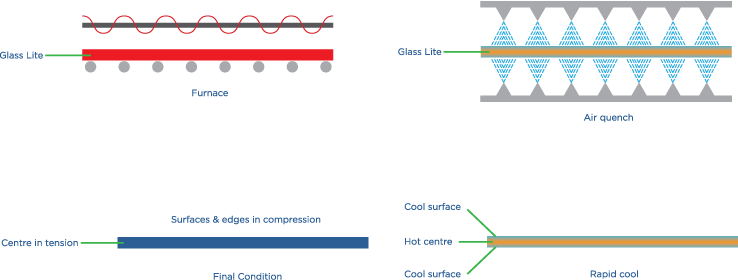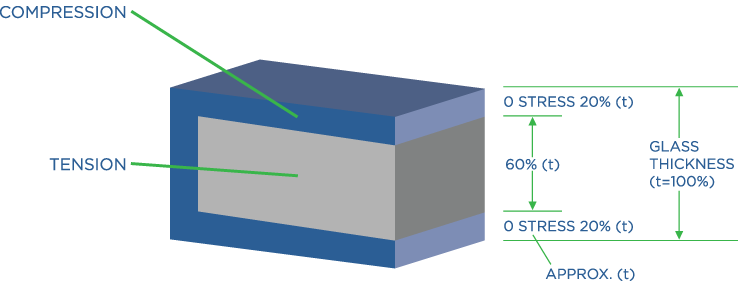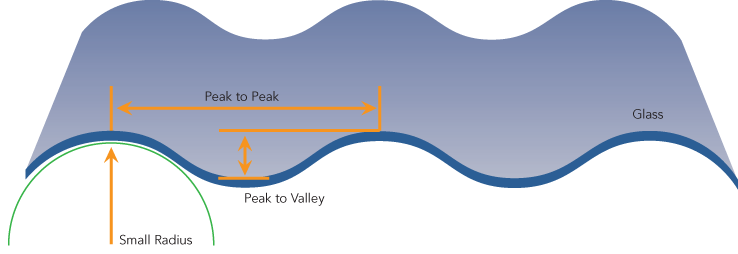Education
Heat-Treated Glass
The durability and strength of regular float glass is suitable under normal conditions, but its thermal resistance and strength are limited without further processing. Where added resistance to wind load, thermal stress and additional mechanical strength is needed (i.e. holes and notches), float glass must be heat-treated in order to increase its strength.
Vitrum offers heat-treated glass in both fully tempered and heat-strengthened. These two heat-treated glass products provide distinctively different benefits and performance enhancements.
| Annealed Glass | Tempered Glass | Heat-Strengthened Glass | |
|---|---|---|---|
| Strength | Approximately 4 times stronger than annealed glass of equal thickness | Approximately 2 times stronger than annealed glass of equal thickness | |
| Break Pattern |  Large shards that will likely fall from the glazing pocket. Large shards that will likely fall from the glazing pocket. |  Small pebble like pieces of glass that will crumble and fall out of the glazing pocket. Small pebble like pieces of glass that will crumble and fall out of the glazing pocket. |  Moderate size pieces that will likely remain within the glazing pocket when broken. Moderate size pieces that will likely remain within the glazing pocket when broken. |
| Thermal Resistance | None | Yes | Yes |
| Safety Glazing | No | Yes | No |
| Susceptible to Nickel Sulfide Inclusions | No | Yes – Heat Soak Testing may need to be specified | No |


Tempered glass is produced by first cutting and processing annealed flat glass. After the glass has been cut and fabricated it is loaded into a horizontal furnace that has a bed of oscillating rollers where the glass will be heated to 1150°F (621°C.).
When the centre of glass meets the set temperature it exits the furnace and is rapidly cooled (quenched) by cool air blown on both sides of the glass surface. This cooling process creates a state of high compression on the glass surface, while the cores is locked in a state of tension, as shown in the diagram.
The minimum surface compression for fully tempered glass is 10,000 psi, while the edge compression should be no less than 9,700 psi.
Considerations when specifying heat-treated glass
Heat Treatment of glass is necessary when the risk of thermal breakage needs to be lowered, or the windload resistance of the glass lite must be improved, or when safety glazing is required (only tempered glass).
However, due to the aesthetic changes of heat treated glass products, design professionals and specifiers should consider the appropriateness of using heat-treated glass products and understand the aesthetic limitations.
The visible effects of heat-treatment may become accentuated if two or more lites of heat-treated glass are combined (i.e laminated glass or an insulated glass unit).
Roll Distortion
Roll distortion is the periodic wave imparted to glass during heat treatment. The viewer perceives the roll wave as optical distortion in the reflection or transmission of the finished window. These roll waves are always present at some level in heat treated glass due to the glass being transported horizontally on rollers in the tempering furnace and is not a defect.
To minimize the visible effects of roll distortion, glass is tempered whenever possible with roll wave running horizontal to the base of the glass. An observer walking past the building will not see roll wave distortion if the glass is tempered this way. As roll wave distortion is inherently found in all tempered glass Vitrum recommends a full size production mock-up be created and viewed if reflected image distortion is of concern.

Uses for Tempered Glass
Tempered glass is intended for general glazing, as well as safety glazing. It is often used for the following applications:
- Shower/bath enclosures
- Doors & Side-lites
- Storm doors
- Building entrances
- Automotive
- Railings
- Fabricated glass (holes, notches, cut-outs)
Strain Patterns
Strain pattern (or quench patterns) in tempered or heat strengthened glass are sometimes visible, usually on reflection or under certain polarizing lighting conditions (i.e a clear north sky, sunlight reflected at a polarizing angle or when viewed through polarized sunglasses). This strain pattern will appear as an iridescent effect, which may be a checkerboard, faint spots, lines or a multi-circular pattern related to the nozzles used in the quench section of a horizontal tempering furnace.
Strain pattern, seen with certain lighting conditions is an inherent property of all tempered and heat strengthened glass and cannot be considered a defect. Nothing can be done to eliminate this effect when the lighting conditions are present to observe it. Strain pattern when visible is a positive confirmation that the glass has been heat treated.
The American Society for Testing and Materials (ASTM) provides a standard on heat-treated glass products. This standard is C1048-04 Heat Treated Flat Glass – Kind HS, Kind FT Coated and Uncoated Glass. In this standard, strain pattern is recognized and identified as follows:
7.5 Strain Pattern – “In heat strengthened and fully tempered glass, a strain pattern, which is not normally visible, may become visible under certain lighting conditions. It is a characteristic of these kinds of glass and should not be mistaken as discoloration or non-uniform tint or color.”
In addition, the Glass Association of North America (GANA) defines Strain Pattern as follows:
“The tempering process places glass under very high compression on the surface and high tension in the core of the glass. This results in a specific geometric optical pattern in the glass which is not normally visible, but which may become apparent under certain conditions of illuminations, especially when light is polarized, such as a skylight or other forms of reflected light. The colors of the strain pattern are sometimes referred to as iridescent, or the general condition as iridescence. The pattern that is seen under certain lighting conditions may vary from manufacturer, depending on the design of the cooling apparatus. Strain pattern is characteristic of all fully tempered glass.”
Nickel Sulfide Inclusions and Spontaneous Breakage
All tempered glass poses the risk of spontaneous breakage. Most often this breakage is due to thermal stress, edge quality, impact, or mechanically load. However there are times when spontaneous breakage may suddenly occur due to Nickel Sulfide inclusions. These inclusions are inherent in the production process of float glass, are microscopic in nature and very difficult to detect. When the glass spontaneously breaks the tempered glass splinters into numerous pieces, which can fall out of the opening either wedged together or as individual pieces.
Although the risk of spontaneous breakage is usually minimal, specifiers should take alternatives into consideration, where applicable. Vitrum recommends heat soaked tempered glass, heat-strengthened glass or laminated glass be specified in situations where spontaneous breakage, falling glass and nickel sulfide inclusions are of concern.
Read more about the heat soak process here.